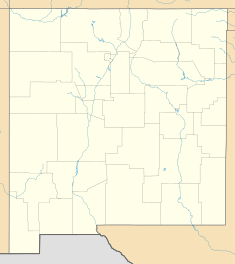San Acacia Diversion Dam facts for kids
The San Acacia Diversion Dam is a structure built in 1934 by the Middle Rio Grande Conservancy District (MRGCD) near San Acacia, New Mexico, United States. Its main job is to take water from the Rio Grande river and send it into special canals for watering farms.
Quick facts for kids San Acacia Diversion Dam |
|
|---|---|
|
Location of San Acacia Diversion Dam in New Mexico
|
|
| Country | United States |
| Location | San Acacia, New Mexico |
| Coordinates | 34°15′23″N 106°53′15″W / 34.256376°N 106.88739°W |
| Purpose | Irrigation |
| Opening date | 1934 |
| Owner(s) | Middle Rio Grande Conservancy District |
| Dam and spillways | |
| Type of dam | Diversion dam |
| Height | 17 feet (5.2 m) |
| Length | 700 feet (210 m) |
How the San Acacia Dam Works
The San Acacia Diversion Dam is located on the Rio Grande river. It's about three-quarters of a mile north of the town of San Acacia, New Mexico.
The dam was built in 1934. It was later fixed up in 1957 by the United States Bureau of Reclamation. This was part of a bigger project called the Middle Rio Grande Project.
The dam is made of concrete. It stands 17 feet (5.2 m) high and stretches 700 feet (210 m) long. It has 29 special gates that can open and close. These gates help control the flow of water.
The dam's main job is to send river water into the Socorro Main Canal. This canal is managed by the MRGCD. The dam can also send water into the Low Flow Conveyance Channel. This channel is managed by the United States Bureau of Reclamation. The Low Flow Conveyance Channel runs for 58 miles (93 km) from the dam down to a narrow area near Elephant Butte Reservoir.
How the Dam Affects the River and Fish
When the dam was built, it changed the river. A report from 2003 found that dirt and sand had built up upstream of the dam. Downstream, the river channels became much narrower. The river also cut a deeper path, making the water flow faster. This made it hard for fish to swim upstream.
Experts suggested adding special structures called Gradient Restoration Facilities. These would help slow the water down. This would allow sand to settle and make it easier for fish to travel. Another idea in 2005 was to remove the dam completely. This would also need Gradient Restoration Facilities to control erosion.
There have been concerns about a special fish called the endangered Rio Grande silvery minnow. This fish was struggling to survive. Because of this, the United States Bureau of Reclamation started working with the United States Fish and Wildlife Service (USFWS). They are trying to save the fish.
Many projects are underway to help the silvery minnow's home. One study is looking at ways to help the fish get past the dam. In 2003, the USFWS said that a way for fish to pass the dam was required. Water is also being released from reservoirs upstream to give the minnow more water. The Department of Reclamation is even renting water from people who own water rights to help the fish. Water from the Low Flow Conveyance Channel is also being pumped into parts of the river that often dry up.
Citations
Sources


